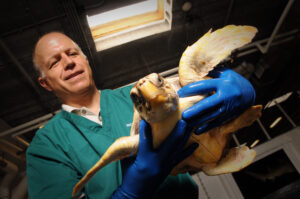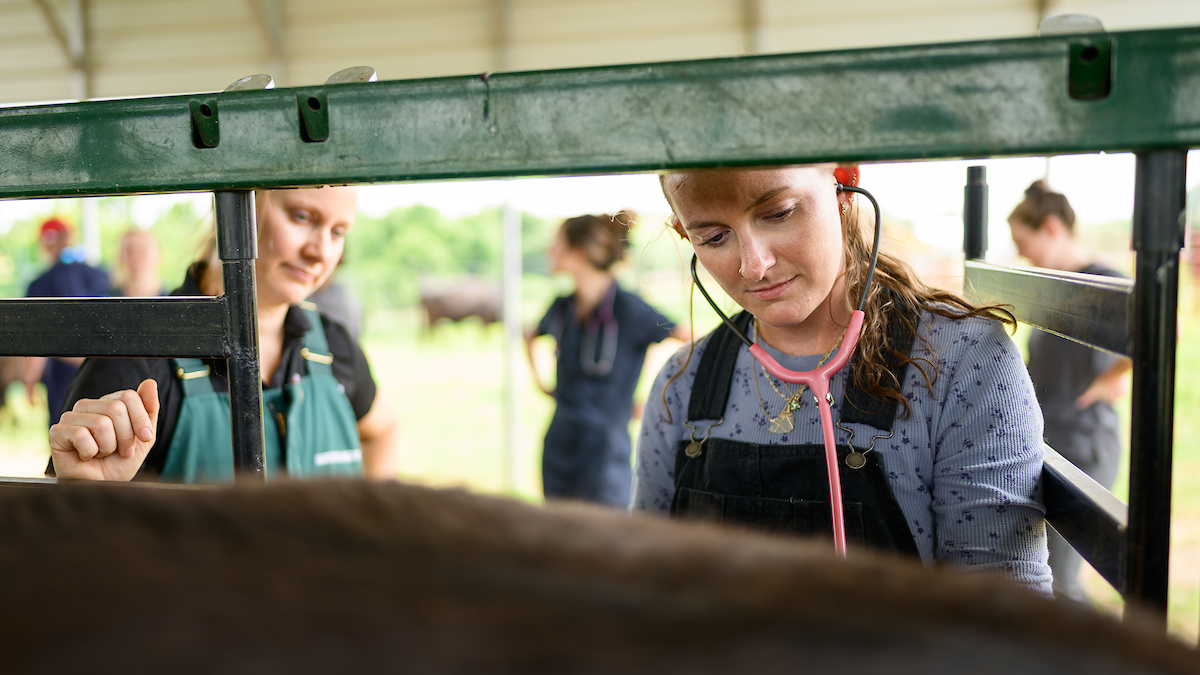NC State Veterinary Medicine Research Roundup, January 2021

A look at some of the latest published research from the CVM.
Canine Heart Health
A point-of-care lung ultrasound (LUS) may be a useful tool for monitoring pulmonary edema in dogs with left-sided congestive heart failure (L-CHF), according to a study co-authored by Teresa DeFrancesco.
The study looks at 25 dogs hospitalized for treatment of first-onset L-CHF, then at the time of discharge and recheck examination, using LUS to determine patterns of edema resolution. Lung ultrasounds have been previously shown to effectively diagnose canine left-sided congestive heart failure through detecting ultrasound artifacts, or B-lines, caused by increased lung water.
The Journal of Veterinary Internal Medicine published the research.
Read the study here.
Marek’s Disease Virus
A study co-authored by Isabel Gimeno finds that the spliced protein transcript Meq-vIL8 is an important virulence factor of Marek’s disease virus (MDV), a cell-associated oncogenic alphaherpesvirus that causes T-cell lymphoma in chickens.
Researchers found that Meq-vIL8 significantly enhanced viral DNA load in the late phase of infection in the spleen and brain of infected chickens. The study also found that removal of Meq-vIL8 expression reduced mean death time and increased the prevalence of persistent neurological disease, common features of highly virulent MDV strains. Vaccines are highly protective, but no treatments for MDV are available.
The Journal of General Virology published the research.
Read the study here.
Dredging Impact on Sea Turtles
Hopper dredge entrainment is an additional cause of gas embolism and potential decompression sickness in sea turtles, according to a study led by Craig Harms.
Researchers studied sea turtles in North Carolina and South Carolina found alive, though with blunt force injuries, after passage through dredges during shipping channel maintenance or beach renourishment activities. Gas embolism in mesenteric vessels, the right atrium and kidneys was detected in several of the green turtles and Kemp’s ridleys studied.
Death of some of the turtles likely resulted primarily from massive tissue trauma from the dredge, but moderate gas embolism could have led to decompression sickness and complicated recovery, researchers found. The study also found that drastic pressure change with dredge pipes before and after pump could contribute to gas embolism.
Diseases of Aquatic Organisms published the research.
Read the study here.
Tracking Worldwide Babesia
In the largest study of its type, researchers including Adam Birkenheuer, have outlined the results of more than 100,000 canine samples submitted to a commercial diagnostic laboratory for Babesia species testing, effectively painting a worldwide overview of pathogenic distribution.
Babesia parasite infections in canines and the resulting family of diseases, babesiosis, is primarily spread through an infected tick bite. Researchers collected the samples from 52 different countries and territories across four continents, conducting Babesia testing by polymerase chain reaction.
Overall, 3.4% of samples tested positive for Babesia species DNA, and Babesia gibsoni was the most commonly identified species, found in 48.8% of the positive results, followed by B. canis (35.2%) and B. vogeli (15.3%). B. gibsoni and B. vogeli were more widely distributed than B. canis, which was primarily found in Europe.
The data also provides guidance to veterinarians about what to possibly expect to find in their practice area. It also shows that molecular assays should target multiple Babesia species in all practice regions.
Veterinary Parasitology: Regional Studies and Reports published the research.
Read the study here.
Treating Feline FGL 
Improved control of feline gastrointestinal intermediate- or large-cell lymphoma (FGL) may be achievable through continued optimization and intensification of a newly tested combined chemoradiotherapy protocol, according to a study authored by Mike Nolan, Gabriela Seiler and Tracy Gieger.
Researchers tested a FGL treatment approach using both lomustine chemotherapy and 8 gy abdominal cavity radiation therapy. The oncological outcomes reported are comparable to those achieved with multi-agent injectable chemotherapy (CHOP), according to the study. Treatment was well-tolerated in most cats.
The Journal of Feline Medicine and Surgery published the research.
Read the study here.
Canine Spinal Cord Injury
Duration of injury should be considered when interpreting diffusion tensor imaging (DTI) results in dogs with acute thoracolumbar intervertebral disc herniation (IVDH), according to a study co-authored by Natasha Olby, Karen Munana, Christopher Mariani and Peter Early.
DTI quantifies microstructural lesion characteristics, but impact of the interval between spinal cord injury and examination on imaging characteristics has been unclear. The study finds that mean diffusivity might differentiate injury severity in the acute setting and may be worthy of development as an imaging biomarker.
The Journal of Neurotrauma published the research.
Read the study here.
~Jordan Bartel/NC State Veterinary Medicine


